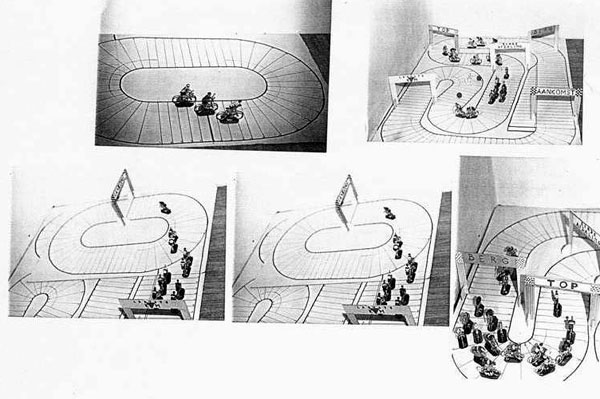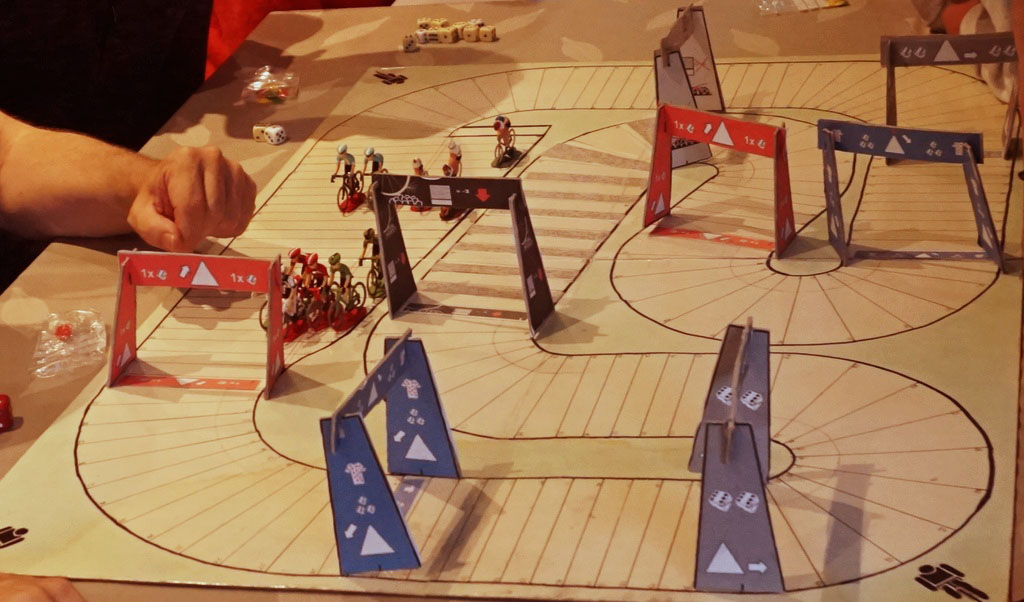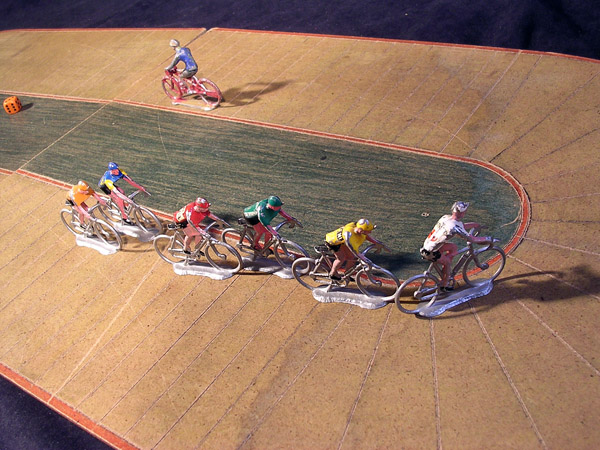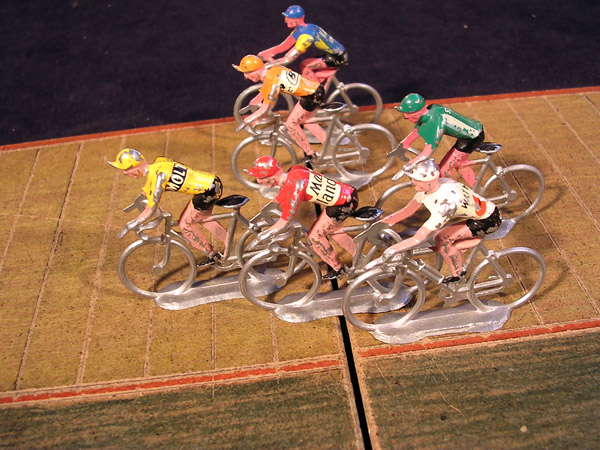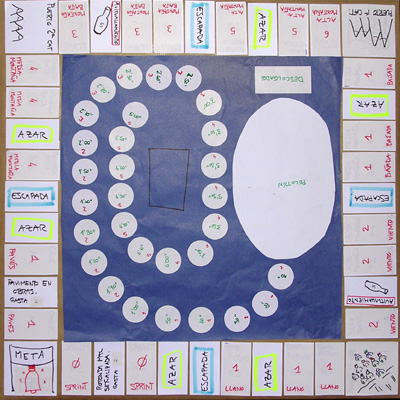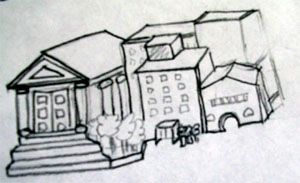UPDATE 2025: The
new version has finally been released. Check it
here.
HOMAS
GAMES, a letter from Harry Hommes
Dear reader,
you can not begin to understand how proud I am to find the game that my father
developed way back when I was a boy. The name of my father is John Hommes, he
was the son of my grandfather who founded the Homas factory. Homas stands for
Hommes (our familyname) and Assen
(our hometown). I can easily recognize his design in the graphics since I have
watched him drawing and sketching for decades. He passed away in 1999, the firm
went broke around 1980. Got to show this to my mum who is turning 80 this year.
Greetings, Harry Hommes, Assen, Holland.


Left: Hendrikus
Hommes. Right:
his son
John Hommes
(behind the camera)
A small
history about the family background concerning the factory. It was founded by my
grandfather Hendrikus Hommes (1894-1973) in 1923 in his hometown Assen, situated
in the north of Holland. In those early years they manufactured
"sjoelbakken" (a typical Dutch familygame, a kind of wooden shuffleboard) and
meter-sticks that people could use to measure fabric. Another polular game in
those days were the yo-yo's. During the war there was a shortage of wood and
because of that my grandfather switched to repairing wooden shoes. After the
war the factory bloomed: brochures from the fifties and sixties showed an
extensive array of games like puzzles, chess-sets, billiards, table tennis,
bowling sets and other (board) games. Some were imported, some were self
invented like the Homas-tour.My father, John Hommes (1926-1999) worked almost his
entire life in his fathers company. During summerholidays it was an ideal place
for me to earn some cash. In 1983 is was "game over", the company went broke,
families stopped playing games together and electronic games stepped in.


The
Homas
building in
Assen
and a picture of the game (brochure 1963-1964)
By the way, according to
Harry Hommes there is a small secret mystery hidden in the game, in the
face of the first cyclist portrayed in the box. See
the box, concentrate on the face of the cyclist up front and tell me if there is
anything that strikes you as odd.....please do and let me know. There is a small
secret there.
Click here to see the
game
HOMAS TOUR, Rob Bontenbal's early
designs
Some years later Homas released another cycling
game, designed by Rob Bontenbal,
HOMAS TOUR (later released as "Um Reifenbreite"
by Jumbo), which happens to the best-selling cycling game ever. I had the
pleasure of meeting Rob, who showed me some early designs of the game. This is not Bob's first design, but it is the one he
used to play with for a long time. The board is HUGE (160 x 120 cm, on 12 40 x
40 cms wooden panels), as you can see by the
chair on the background.

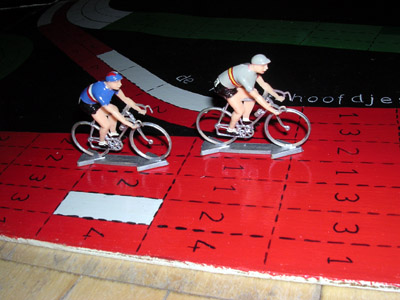
Here are some of the teams he used.



Rules of the original Homas Tour signed by
Rob Bontembal
This game qualifies as a free print-and-play game.
As the rules state, "to play Homas Tour Pro you need a copy of the game Um
Reifenbreite (usually for sale at Ebay for less than 10?, shipping costs
included), or otherwise 24 small cyclists, a set of 52 playing cards and a few
pdf files." These PDF files can be downloaded from
boardgamegeek (along with many team configurations, don't forget to check it
regularly), but you can also get them here:
> English rules (PDF file, 700 KB)
> Random Events table (PDF file, 120 KB)
> Huge board
designed by Ludo Nauws (PDF file, ready to print in 20 A4s, 7MB)
HOW IT BEGAN, by Ludo Nauws
This is the translation of
Ludo's account. The Dutch original is on his website.
I think I was about 12 when I got a box of plastic cyclist
figures. Cycling was part of the family since my father was also is entire life
in cycling and we followed the actions of our heroes live and on TV .
While playing with the miniature cyclist I made all the
famous stages and classics all over again. I made tracks of playing cards and
beer-spills. The beer-spills were the broad, flat
asphalt sections. The playing cards were either small
coblestone sections or uphills. Using the card and spills in different ways I
built always other races.
My own peloton grew soon to 40-50
cyclists. I invented some simple rules to simulate the races. A brief summary:
On the beer-spills there was space for 5 cyclist next to
each other, on the playing cards there was only room
foor 3. The order to roll the dice was the order of the cyclists in the race.
Cyclists couldn?t jump over each other, so when on a
narrow section 3 riders were next to eachother, no other could pass. On the
flat sections cyclist could roll a 3,4 5 or 6 (when rolling a 1 or 2, there was
a re-roll). On the uphill sections the value of the
dice was divided by 2. So cyclist could only move 1, 2 or
3.
When there were coblestone sections
in the race, I had a system to simulate punctures. I
used a small casino roulette. Before starting a new
turn (rolling the dice for the first cyclist), I rolled the roulette and the
figure where the ball stopped was the position of the cyclist who would have a
puncture (not every turn there was a puncture because the cyclist who was marked
by the roulette had to be on a coblestone section). When the cyclist had a
puncture, there was again a roll of the dice to derteminate how many turns
it should take to get another wheel. Here the value of
the dice was again divided by 2.
A cyclist who had moved was aligned to the right of the
track, when there were cyclists next to each other on the same track-section,
the leftmost went first.
In intermediate sprints and at the finish there were points
to gain for the green jersey and also bonus seconds for the yellow jersey. On
the hills there were points for the mountain-classification.
At the finish there was a system to make a classification in
time. For every gap behind the finish line there was a
time delay counted (5 seconds for every track
section). So when there was a gap of 3 track sections
between 2 cyclists there
was a gap of 15 seconds. All cyclists that arrived
whitout a gap between them got the same time. The time-counting at the finish
with intervals of 5 seconds, combined with the bonus seconds at the
intermediate sprints and at the finish made up really
realistic time classification.
When playing the years after that I painted the riders by
myself to give them some jerseys of that saison.
Unfortunately my painting skills were at that time lesser than today. I should
make some repainting one of
these days. I think I will keep the retro-jerseys since the are a lot
easier to paint than the flashy jerseys of today...


KEIRIN, first version
(Click here to see/download the new version as a
real print'and'play game)
Some years ago I was lucky enough to purchase an old hand
made track along with some Salza riders and a Derny (By the way, it got lost by
Italian mail, and I must thank my friend Donato Pompei for helping me to recover
it). Not knowing what to do with it, I tried a fef rules I had in mind for
a solo game. You needed a lot of dice though, one for the first rider, two for
the second... and six for the sixth rider. I published the game on the site and
I listed it as a free print'n'play game, but there was nothing to print ( except maybe the
rules).
I wrote: "You will need a track.
You can use any that belongs to another game or make it one using the templates
in the make your own game section. You will also need six riders in different colours (some available also
in the "make your own game"
section) and 21 dice in six different colours, so that one dice matches the
colour of the first rider, two match the colour of the second rider, and so on,
until the sixth rider, for which you will need six dice. I hope you have that
many dice at home. I do. It is nice (but not necessary) than the cyclists are
bigger than the fields on the track. I like it when the riders occupy three
fields each. That is just because the riders start in every third field, and in
that way they are in a line. As I said, this is not necessary for the game. Equally, it is nice to have a derny figurine, but
just for the ambiance."
Here is what it looked like:
